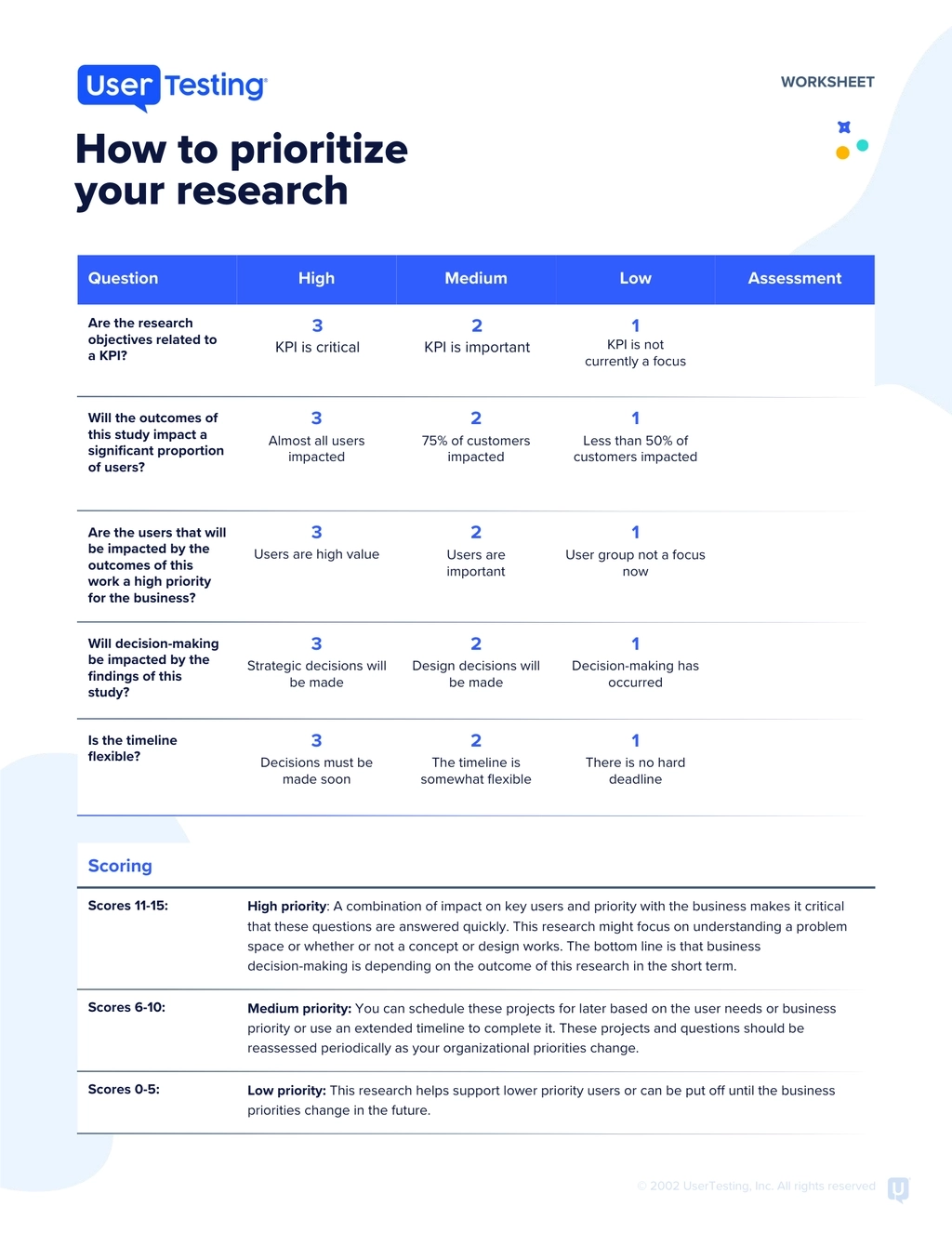
5 questions to help prioritize your research

Whether your organization is large or small, one question we’ve heard again and again is about how teams should prioritize research initiatives. Something to the tune of:
How do research teams prioritize research needs when everything appears to be a priority?
To make matters even more challenging, many research teams are lean, leaving little time to conduct all the research proposed by the business. So in order to maintain efficiency, the ruthless prioritization of research requests is critical to ensure the success, timeliness, and usefulness of the outcomes tied to research activities.
Overcoming the challenge of research prioritization
While there’s no one-size-fits-all approach to prioritizing which initiatives are most impactful for your business, we’ve developed five simple questions to help frame your decision. I first started to develop these questions when I was faced with a list of over 100 potential research questions that I needed to help a researcher prioritize. All had merit, but not all of them mattered. This framework helped to bring some clarity and surface tactical work that would, down the road, result in outcomes easily tied to issues, ideas, and initiatives that mattered to the business.
We’ve learned that most organizations have two types of questions they are thinking about; what should we be planning strategically to move the needle and what are we doing now to build the most elegant and useful products? Use the worksheet below, which features a scoring model, to help guide your decision-making and defend your decisions.

What to ask to prioritize research initiatives
Creating effective UX research questions is crucial in gaining the most useful customer insights. The questions below are designed to help bring focus to product-oriented research. Keep in mind: these are very tactical questions meant for tactical situations. For every incoming project, you should answer the following:
1. Are the research objectives related to a KPI?
This question will help you size up the relevance and impact your research has on the metrics your business is measurings. From increasing conversions on a website to driving more daily active users in your SaaS product, research that’s related to KPI-driven activities should be weighed more heavily than projects that are not.
The added benefit here is when you are asked about the impact of that research, you can tie back your ROI calculations to tangible and relatable objectives that you know the business is tracking.
2. Will the outcomes of this study impact a significant proportion of users?
When working through a research request, ask how the outcomes of your study will impact your users—especially how many. It may seem obvious, but research outcomes that impact all (or almost all) of your users should be prioritized over studies that impact less than half, for example.
3. Are the impacted users a high priority for the business?
While no customer of yours should be viewed as less important than the next, when prioritizing research, the reality is that focusing on critical types of customers drives the bottom line for many companies. Sometimes, this means it’s important to focus on users who may spend more money with your business, and other times it’s not. This could also mean that the new focus should be a sales segment, persona, group experiencing significant problems, or some other qualifying characteristic.
4. Will decision-making be affected by the findings of this study?
The reality is that sometimes we’re asked to do research in hindsight to confirm or validate a decision that has already been made. This type of research isn’t actually intended to be something designers or developers react to in an effort to improve the experience—which should always be the goal.
To avoid this, consider whether the group(s) asking for research have a history of actually implementing recommendations based on research findings. To go one step further, ask how the recommendations need to be timed to ensure that they align with development timelines.
Some researchers will even go so far as to decline research requests based on whether or not teams have implemented changes based on previous research findings. This behavior serves as a means to prioritize research that will make an impact and ensure that colleagues plan to integrate user feedback into their process. The bottom line here is that you should prioritize learning about issues that developers and designers are going to take action on.
5. Is the timeline flexible?
This question is pretty straightforward. When answering this question, consider prioritizing research that lines up with hard deadlines over research that doesn't.
Communicating research priorities back to stakeholders
It’s no secret that prioritizing research can be a challenge, and communicating prioritization decisions back to the business can be daunting. Because everyone thinks their initiatives are important—and to some extent, they are. By prioritizing your research projects objectively, you and your team will be confident that your research initiatives are meeting the needs of the business and keeping your customers at the center of everything you do.
Guide
Smarter, faster feature prioritization
Prioritize product features using customer insights to drive better product decisions





